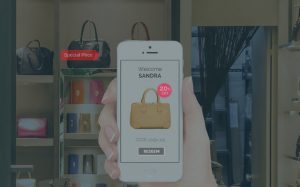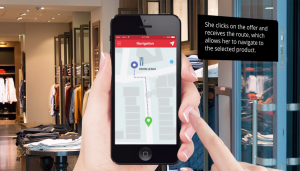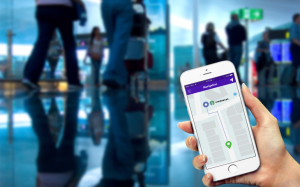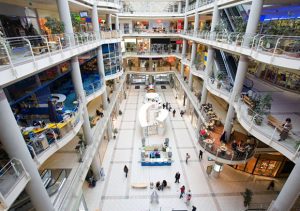Today when ecommerce is eating into the sales of brick and mortar retail chains, proximity-based marketing strategies can revive sales and increase customer engagement. This is where iBeacons can play an important role in helping retailers boost sales. But before we talk about iBeacons, we need to understand the basics of beacons.
Beacons
Beacons are hardware devices that can emit and receive BLE signals. BLE stands for Bluetooth Low Energy. These are low-power devices that communicate using the new Bluetooth Core Specification Version 4.0. They have a range of up to 50 meters. Some manufacturers allow users to adjust broadcasting power, which directly affects the range of the beacon.
Beacons range in price from $5 per unit to $30 for a beacon. The battery life of the devices depends upon their size, use and manufacturer. Some beacon makers are offering devices that last up to 2 years.
iBeacon
iBeacon is the software framework created by Apple to enable Apple devices to communicate with beacons. Third-party manufacturers have built beacons that can send iBeacon messages to Apple devices.
Apple’s iBeacon capability is built into its devices through the iOS mobile operating system. There are already 200 million iOS devices that can serve as transmitters and receivers. Other technologies like GPS are great at finding a building but cannot help smartphone users once they are inside a building.
How iBeacons work
The user’s smartphone is the receiver and the beacon installed is the transmitter. When the user walks into range of the beacon, it sends a signal to the receiver and triggers an event. Apple has divided the range of beacons into four proximity states:
• Immediate – works within a few centimeters
• Near – a range of approximately one to three meters
• Far – more than 10 meters away
• Unknown – proximity of the beacon cannot be determined
Beacons and customer reactions
A consumer readiness survey carried out in 2013 suggested most consumers were looking forward to getting offers from their favorite retail stores. The survey, conducted by Swirl, studied the shopping preferences of 1,000 smartphone owners. It found:
Shoppers like smartphone alerts
• 67% have received shopping-related alerts on their smartphones in the past six months
• Of those 67% respondents, 81% said that they read/open them most of the time
• 79% have consequently made a purchase at least once
Who do shoppers trust more with their smartphones’ location data?
• 77% of consumers are willing to share their location information, as long as they receive enough value in return.
When do consumers like to use retailers’ mobile apps?
• 80% – In-store alerts about sales/deals
• 62% – Content relevant to their interests/locations
Ashley’s day out – how iBeacons help convert footfall into customers
Drive store traffic
Ashley is walking around in a mall doing window shopping when she comes within a few meters of her favorite store whose app she has installed on her smartphone. The shop’s beacon ‘recognizes’ Ashley’s phone and sends her a special offer via the app to get her in the store.
Customer service
Since Ashley is a regular shopper at the store, she is treated as an important client by the store’s manager. When she enters, she gets a welcome message and at the same time the sales assistant is alerted that a loyal customer is in the store. The store can now offer personalized service to high value customers like her.
Special offers
Ashley is now browsing through the store’s various sections and comes to the summer collection section. While she is checking out the latest collection, she gets an offer of 15% discount on her smartphone.
Easier and faster checkout
Ashley wants to use the offer at the checkout counter and clicks on the offer. A bar code for the coupon is saved on the phone in the retailer’s mobile app. Ashley continues shopping and takes advantage of four more discounts offered to her.
Cost savings for the retailer
Retailers can cut down on their print ads, the purpose of which is often to offer customers discount coupons. Retailers can also save on freight costs for shipping paper coupons to the chain’s stores across the country.
iBeacons in use
Apple
Apple has implemented iBeacons in all of its 254 retail stores in the US.
Carrefour and Nisa
French retailer Carrefour and British retailer Nisa have implemented beacons in their trolleys and baskets to track shoppers in a pilot project.
iBeacons – myths and reality
iBeacons can be a very useful marketing tool but they do have their limitations and there are privacy concerns that retailers need to address.
Myth 1: Consumers believe that they will be spammed by advertisements once retailers start using beacons.
Fact: iBeacons operate on the principle of push notification. A user cannot be ‘spammed’ unless he allows the retailer access to his phone. The user will receive an offer or any kind of advertisement only when he has downloaded the retailer’s app, activated his Bluetooth and is in range of the retailer’s beacons. Beacons work only with the apps that they are designed to work with. Beacons are 100% opt-in.
Myth 2: Beacons send content to the phone.
Fact: Beacons cannot transmit content. The user’s phone recognizes a beacon when it is in the vicinity of one and this triggers an action in the related app. The beacon’s signal is more of a ‘wake-up’ call to the user’s phone than an intrusion. Push notifications, coupons, and directions are delivered by the app. To see this content the user needs to access the internet via wi-fi or a mobile internet plan.
Myth 3: Installing iBeacons involves creating a special system and app.
Fact: Businesses can integrate iBeacons into their existing app and enhance it. There is no need to create a new, separate app just to use iBeacons. It can even be integrated into Apple’s Passbook if your business does not have an app. Passbook is on nearly every iPhone and since it’s an existing “utility” application on Apple devices, it’s already set up to work with iBeacons without having to use an app.
Myth 4: Beacons can be used to track a user’s exact movement.
Fact: The user’s devices can only derive the proximity from the BLE signal that is being emitted from the beacon. Beacons can help the retailer identify if the user is near or far away but not the exact distance. Beacons are ideal for helping users with indoor navigation. The way this will work is that beacons will help with the navigation by knowing which beacons are nearby to determine where the user is located (the particular aisle or at the entrance of the store).
Myth 5: Beacons are battery drainers
Fact: The beacon devices operate on BLE (Bluetooth Low Energy) which means that batteries last for months and in some manufacturers’ products for up to 2 years. The new smartphones come equipped to handle the Bluetooth 4.0 standard (BLE) which means even at the user end; beacons are not going to be battery drainers.
Myth 6: iBeacons work only on iPhones
Fact: iBeacon devices are transmitters of BLE (Bluetooth Low Energy) and can be accessed by not just iOS devices but are supported by all the major mobile operating systems – Android, Windows Phone and BlackBerry. Even OS X, Linux and Windows 8 natively support this Bluetooth standard (basically any device that runs the latest version of Bluetooth).
Myth 7: iBeacons collect information from the user without his permission
Fact: The user has to download the retailer’s specific app to take advantage of the offers and information that he sends using the iBeacons system. The kind of data that the application tracks depends on the application and has nothing to do with the iBeacon.
The real world retail experience is becoming less important to consumers and iBeacons is a great tool to keep customers engaged.
originally posted on internetretailing.net
Softweb Solutions
866-345-7638
info@softwebsolutions.com
How iBeacons can save retailers and increase sales
Need Help?
We are here for you
Step into a new land of opportunities and unearth the benefits of digital transformation.






